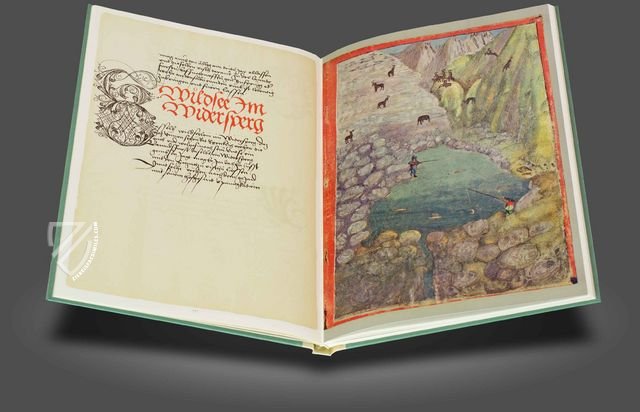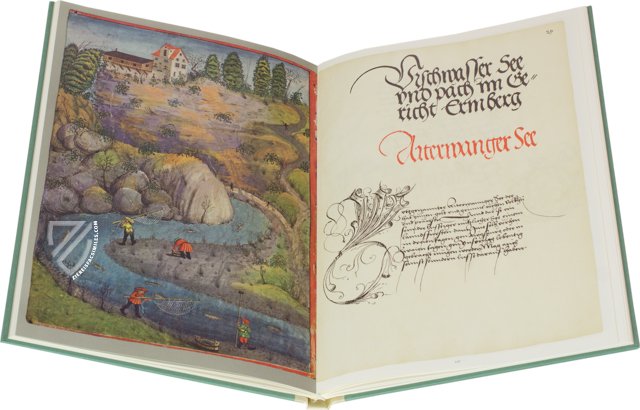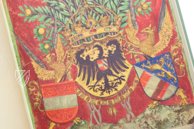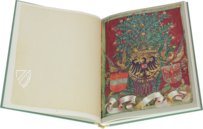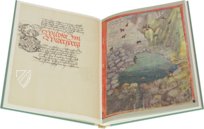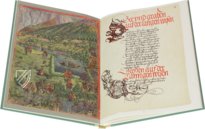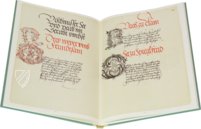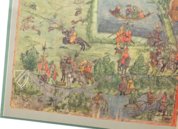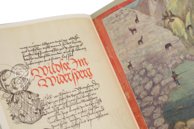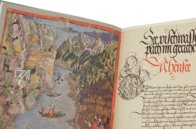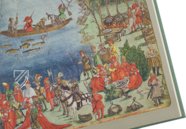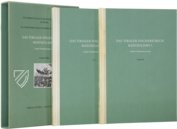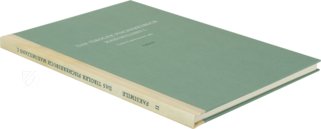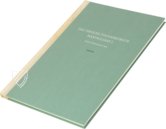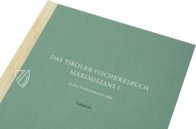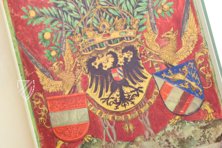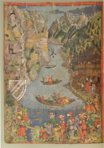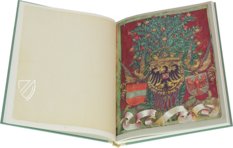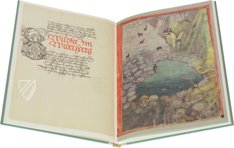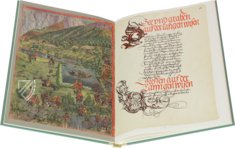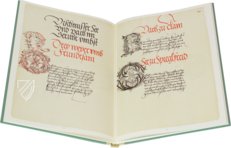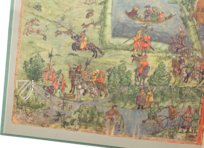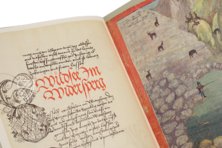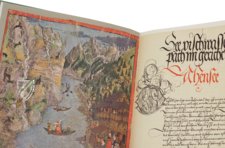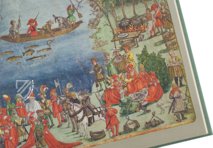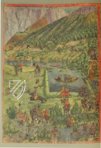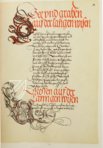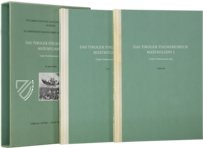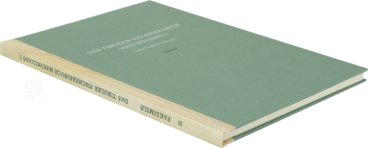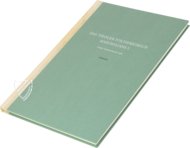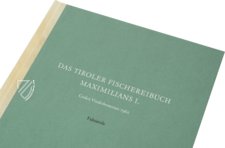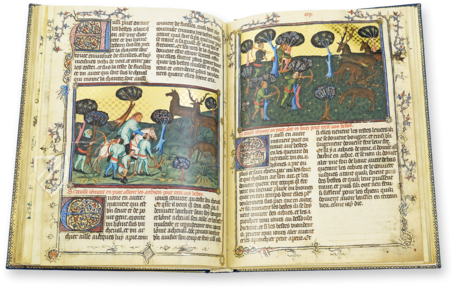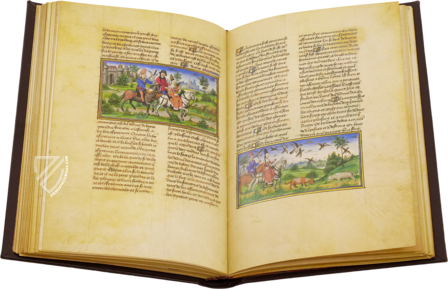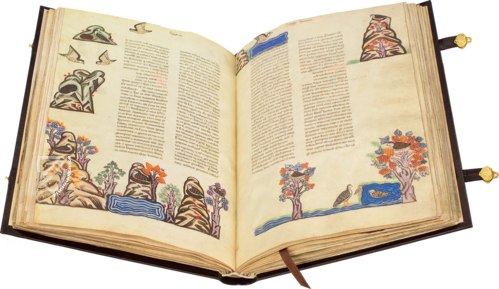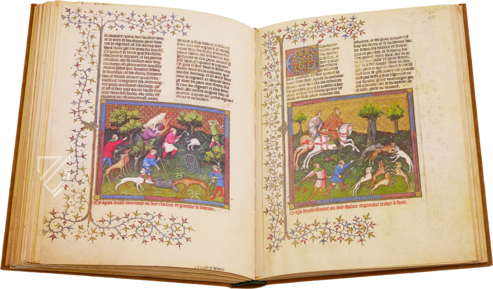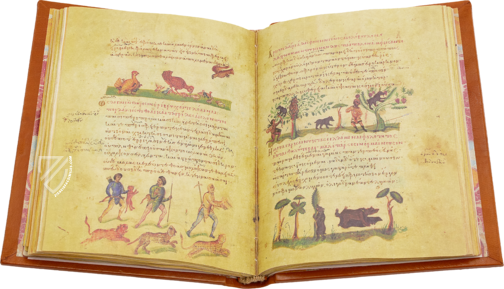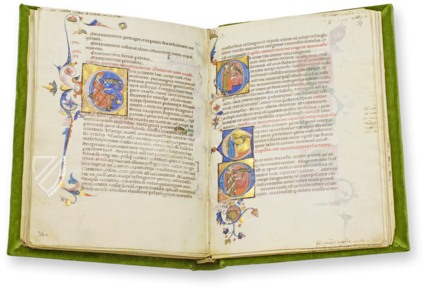Tyrolean Fishing Book of Emperor Maximilian
(under 1,000€)
This 500-year-old fishing book is not only one of the oldest of its kind, but also a masterpiece worthy of one of the greatest art patrons of the Renaissance: Emperor Maximilian I. He was not only a great military strategist and ruler, but also an enthusiastic hunter and fisherman. As such, he commissioned this magnificently illuminated book, which was intended to impart knowledge on the use, care, and protection of Tyrolean fish stocks both for the pleasure of fishing and to ensure the provisioning of the sovereign and his entourage. The descriptions of the Tyrolean Fishing Book of Emperor Maximilian I. are dedicated to specific types of waters, techniques, equipment, and seasons suitable for catching different species of fish. Richly detailed, colorful miniatures provide scenic illustrations to accompany the text. The fact that the text is legible for modern readers with a little practice adds to the manuscript's appeal. The book is not only interesting for anglers and fishermen, but also for biologists, historians, and art lovers.
Tyrolean Fishing Book of Emperor Maximilian
Maximilian I (1459–1519) Archduke of Austria and Holy Roman Emperor was one of the most influential figures of the Late Middle Ages. He combined the ideals of a medieval warrior-king, not only fighting personally in battle but placing himself in the front line, with that of a learned Renaissance prince, establishing himself not only as a great patron of the arts but an author in his own right. Although successful as a warrior, it was his marriage politics that allowed him to expand Hapsburg rule into much of the former Duchy of Burgundy, claiming the richness of the Netherlands, and into Bohemia and Hungary. His living descendants include King Felipe VI of Spain and Queen Elizabeth II of the United Kingdom. This policy has been described as: "Let others wage war, but thou, O happy Austria, marry; for those kingdoms which Mars gives to others, Venus gives to thee." When not occupied by affairs of state, Maximilian loved hunting and fishing. The Tyrolean Fishing Book of Emperor Maximilian was written by Wolfang Hohenleiter, an author specializing in hunting and fishing, and was illuminated by Jörg Kölderer (ca. 1465–1540), Maximilian’s court painter and architect. Dated to 1504, it is a splendid manuscript that is of interest not only to anglers, but to biologists, historians, and art lovers as well.
Managing Tyrol’s Fish Stocks
Maximilian’s purpose in commissioning this manuscript was not merely to describe what kinds of fish lived where and how best to eat them, nor did he intend it purely for his own use. While his love of fishing certainly played a role, it was how best to exploit, manage, and protect these resources that motivated the Emperor for the nourishment of future sovereigns and their retinues. The fact that the names of the fish and bodies of water, as well as the dialect of Tyrol have not changed significantly in the last 500 years means that, with a little practice, the text of this work is quite accessible to modern readers. Specific bodies of water, techniques, equipment, and times of year for catching various types of fish are detailed both in the text and in the miniatures, which are remarkable for their detail and realism. Most of the bodies of water are small, including so-called “wild lakes”, and although large lakes like the Achensee, Plansee, and Kalterer See are mentioned, large rivers like the Inn, Lech, and Etsch are not. With a few exceptions, only sovereign-owned bodies of water are depicted, 110 in all, with most no longer existing. Perhaps this is because the manuscript appears to be incomplete, which is indicated by some empty pages in various parts of the work. Aside from the fourteen miniatures, some of which are full-pages, gorgeous coats of arms and decorative initials in red and black adorn the text, which is written in an elegant hand. Today, the precious artifact, one of the oldest of its kind, is stored among the illustrious collections of the Austrian National Library under the shelf mark Codex Vindobonensis 7962.
Codicology
- Alternative Titles
- Fischereibuch Kaiser Maximilians I
Das Tiroler Fischereibuch Maximilians I
Fischereibuch of Emperor Maximilian I - Size / Format
- 112 pages / 33.2 × 23.2 cm
- Origin
- Austria
- Date
- 1504
- Epochs
- Style
- Genre
- Language
- Illustrations
- 14 miniatures, some of them full-page and many black and red initials
- Patron
- Maximilian I, Holy Roman Emperor (1459–1519)
- Artist / School
- Wolfgang Hohenleiter (author)
Jörg Kölderer (illuminator)
Tyrolean Fishing Book of Emperor Maximilian
Duck Hunting with Falcons
Falconry was an important sport and status symbol among the medieval European nobility that required plenty of time, money, and space to practice. These three falconers are hunting for mallards, whose characteristic green heads can be clearly seen. One is richly dressed in black and yellow striped clothing, sitting on a horse, and holding out his arm as though he is about to unleash his falcon on the duck overhead. Another, dressed in a red tunic with knee-high boots, swings a lure in the air.
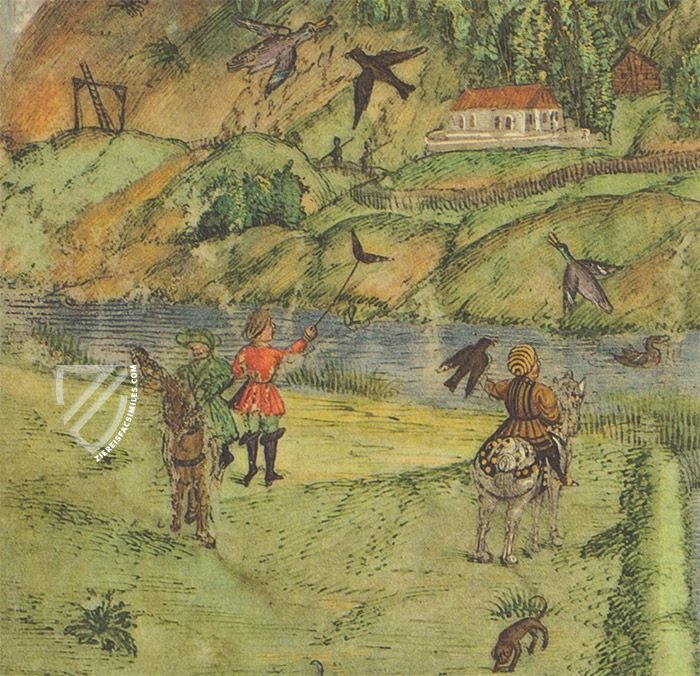
Tyrolean Fishing Book of Emperor Maximilian
Fishing on Lake Achen
Called the Achensee in German, this deep Alpine lake is the largest in Tyrol and was a valuable fishery during the Middle Ages, which continues to boasts an extraordinary variety of fish today. It was also a favorite destination for the Austrian nobility to engage in elegant hunting and fishing parties and was beloved by Emperor Maximilian in particular.
A group of extravagantly dressed noblemen can be seen in the foreground of the miniature as fishermen pull in their catch with nets. Rams climb about the crags of the mountainside to the left while deer run through the woods to the right, both pursued by hunters. The Hapsburg coat of arms and Imperial Eagle seen above the front door indicate that the house is a residence of Maximilian’s.
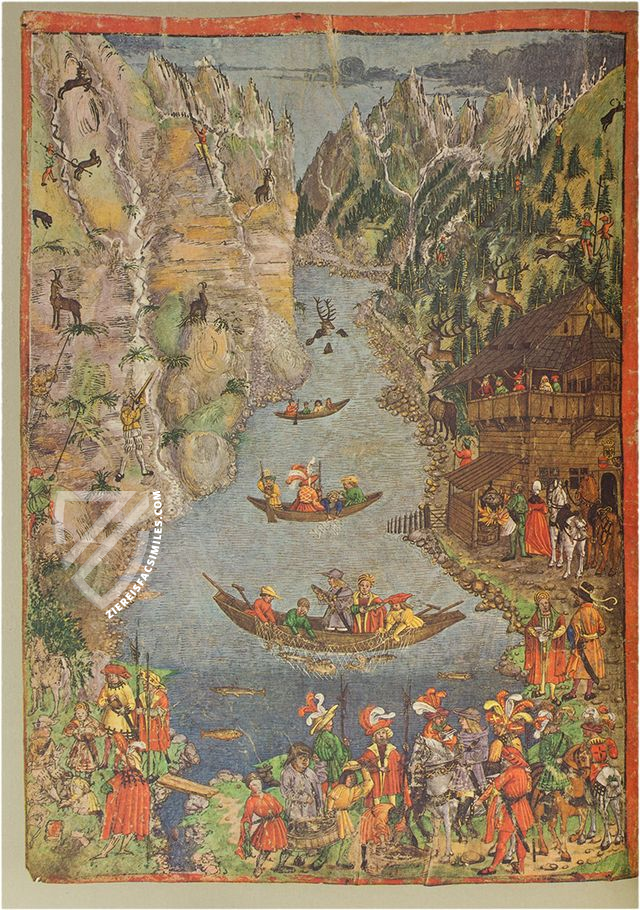
#1 Tiroler Fischereibuch Maximilians I.
Language: German
(under 1,000€)
- Treatises / Secular Books
- Apocalypses / Beatus
- Astronomy / Astrology
- Bestiaries
- Bibles / Gospels
- Chronicles / History / Law
- Geography / Maps
- Saints' Lives
- Islam / Oriental
- Judaism / Hebrew
- Single Leaf Collections
- Leonardo da Vinci
- Literature / Poetry
- Liturgical Manuscripts
- Medicine / Botany / Alchemy
- Music
- Mythology / Prophecies
- Psalters
- Other Religious Books
- Games / Hunting
- Private Devotion Books
- Other Genres
- Afghanistan
- Armenia
- Austria
- Belgium
- Belize
- Bosnia and Herzegovina
- China
- Colombia
- Costa Rica
- Croatia
- Cyprus
- Czech Republic
- Denmark
- Egypt
- El Salvador
- Ethiopia
- France
- Germany
- Greece
- Guatemala
- Honduras
- Hungary
- India
- Iran
- Iraq
- Israel
- Italy
- Japan
- Jordan
- Kazakhstan
- Kyrgyzstan
- Lebanon
- Liechtenstein
- Luxembourg
- Mexico
- Morocco
- Netherlands
- Palestine
- Panama
- Peru
- Poland
- Portugal
- Romania
- Russia
- Serbia
- Spain
- Sri Lanka
- Sweden
- Switzerland
- Syria
- Tajikistan
- Turkey
- Turkmenistan
- Ukraine
- United Kingdom
- United States
- Uzbekistan
- Vatican City
- A. Oosthoek, van Holkema & Warendorf
- Aboca Museum
- Ajuntament de Valencia
- Akademie Verlag
- Akademische Druck- u. Verlagsanstalt (ADEVA)
- Aldo Ausilio Editore - Bottega d’Erasmo
- Alecto Historical Editions
- Alkuin Verlag
- Almqvist & Wiksell
- Amilcare Pizzi
- Andreas & Andreas Verlagsbuchhandlung
- Archa 90
- Archiv Verlag
- Archivi Edizioni
- Arnold Verlag
- ARS
- Ars Magna
- ArtCodex
- AyN Ediciones
- Azimuth Editions
- Badenia Verlag
- Bärenreiter-Verlag
- Belser Verlag
- Belser Verlag / WK Wertkontor
- Benziger Verlag
- Bernardinum Wydawnictwo
- BiblioGemma
- Biblioteca Apostolica Vaticana (Vaticanstadt, Vaticanstadt)
- Bibliotheca Palatina Faksimile Verlag
- Bibliotheca Rara
- Boydell & Brewer
- Bramante Edizioni
- Bredius Genootschap
- Brepols Publishers
- British Library
- C. Weckesser
- Caixa Catalunya
- Canesi
- CAPSA, Ars Scriptoria
- Caratzas Brothers, Publishers
- Carus Verlag
- Casamassima Libri
- Centrum Cartographie Verlag GmbH
- Chavane Verlag
- Christian Brandstätter Verlag
- Circulo Cientifico
- Club Bibliófilo Versol
- Club du Livre
- CM Editores
- Collegium Graphicum
- Collezione Apocrifa Da Vinci
- Comissão Nacional para as Comemorações dos Descobrimentos Portugueses
- Coron Verlag
- Corvina
- CTHS
- D. S. Brewer
- Damon
- De Agostini/UTET
- De Nederlandsche Boekhandel
- De Schutter
- Deuschle & Stemmle
- Deutscher Verlag für Kunstwissenschaft
- DIAMM
- Droz
- E. Schreiber Graphische Kunstanstalten
- Ediciones Boreal
- Ediciones Grial
- Ediclube
- Edições Inapa
- Edilan
- Editalia
- Edition Deuschle
- Edition Georg Popp
- Edition Leipzig
- Edition Libri Illustri
- Editiones Reales Sitios S. L.
- Éditions de l'Oiseau Lyre
- Editions Medicina Rara
- Editorial Casariego
- Editorial Mintzoa
- Editrice Antenore
- Editrice Velar
- Edizioni Edison
- Egeria, S.L.
- Eikon Editores
- Electa
- Emery Walker Limited
- Enciclopèdia Catalana
- Eos-Verlag
- Ephesus Publishing
- Ernst Battenberg
- Eugrammia Press
- Extraordinary Editions
- Fackelverlag
- Facsimila Art & Edition
- Facsimile Editions Ltd.
- Facsimilia Art & Edition Ebert KG
- Faksimile Verlag
- Feuermann Verlag
- Folger Shakespeare Library
- Franco Cosimo Panini Editore
- Friedrich Wittig Verlag
- Fundación Hullera Vasco-Leonesa
- G. Braziller
- Gabriele Mazzotta Editore
- Gebr. Mann Verlag
- Gesellschaft für graphische Industrie
- Getty Research Institute
- Giovanni Domenico de Rossi
- Giunti Editore
- Graffiti
- Grafica European Center of Fine Arts
- Guido Pressler
- Guillermo Blazquez
- Gustav Kiepenheuer
- H. N. Abrams
- Harrassowitz
- Harvard University Press
- Helikon
- Hendrickson Publishers
- Henning Oppermann
- Herder Verlag
- Hes & De Graaf Publishers
- Hoepli
- Holbein-Verlag
- Houghton Library
- Hugo Schmidt Verlag
- Idion Verlag
- Il Bulino, edizioni d'arte
- ILte
- Imago
- Insel Verlag
- Insel-Verlag Anton Kippenberger
- Instituto de Estudios Altoaragoneses
- Instituto Nacional de Antropología e Historia
- Introligatornia Budnik Jerzy
- Istituto dell'Enciclopedia Italiana - Treccani
- Istituto Ellenico di Studi Bizantini e Postbizantini
- Istituto Geografico De Agostini
- Istituto Poligrafico e Zecca dello Stato
- Italarte Art Establishments
- Jan Thorbecke Verlag
- Johnson Reprint Corporation
- Josef Stocker
- Josef Stocker-Schmid
- Jugoslavija
- Karl W. Hiersemann
- Kasper Straube
- Kaydeda Ediciones
- Kindler Verlag / Coron Verlag
- Kodansha International Ltd.
- Konrad Kölbl Verlag
- Kurt Wolff Verlag
- La Liberia dello Stato
- La Linea Editrice
- La Meta Editore
- Lambert Schneider
- Landeskreditbank Baden-Württemberg
- Leo S. Olschki
- Les Incunables
- Liber Artis
- Library of Congress
- Libreria Musicale Italiana
- Lichtdruck
- Lito Immagine Editore
- Lumen Artis
- Lund Humphries
- M. Moleiro Editor
- Maison des Sciences de l'homme et de la société de Poitiers
- Manuscriptum
- Martinus Nijhoff
- Maruzen-Yushodo Co. Ltd.
- MASA
- Massada Publishers
- McGraw-Hill
- Metropolitan Museum of Art
- Militos
- Millennium Liber
- Müller & Schindler
- Nahar - Stavit
- Nahar and Steimatzky
- National Library of Wales
- Neri Pozza
- Nova Charta
- Oceanum Verlag
- Odeon
- Orbis Mediaevalis
- Orbis Pictus
- Österreichische Staatsdruckerei
- Oxford University Press
- Pageant Books
- Parzellers Buchverlag
- Patrimonio Ediciones
- Pattloch Verlag
- PIAF
- Pieper Verlag
- Plon-Nourrit et cie
- Poligrafiche Bolis
- Presses Universitaires de Strasbourg
- Prestel Verlag
- Princeton University Press
- Prisma Verlag
- Priuli & Verlucca, editori
- Pro Sport Verlag
- Propyläen Verlag
- Pytheas Books
- Quaternio Verlag Luzern
- Reales Sitios
- Recht-Verlag
- Reichert Verlag
- Reichsdruckerei
- Reprint Verlag
- Riehn & Reusch
- Roberto Vattori Editore
- Rosenkilde and Bagger
- Roxburghe Club
- Salerno Editrice
- Saltellus Press
- Sandoz
- Sarajevo Svjetlost
- Schöck ArtPrint Kft.
- Schulsinger Brothers
- Scolar Press
- Scrinium
- Scripta Maneant
- Scriptorium
- Shazar
- Siloé, arte y bibliofilia
- SISMEL - Edizioni del Galluzzo
- Sociedad Mexicana de Antropología
- Société des Bibliophiles & Iconophiles de Belgique
- Soncin Publishing
- Sorli Ediciones
- Stainer and Bell
- Studer
- Styria Verlag
- Sumptibus Pragopress
- Szegedi Tudomànyegyetem
- Taberna Libraria
- Tarshish Books
- Taschen
- Tempus Libri
- Testimonio Compañía Editorial
- Thames and Hudson
- The Clear Vue Publishing Partnership Limited
- The Facsimile Codex
- The Folio Society
- The Marquess of Normanby
- The Richard III and Yorkist History Trust
- Tip.Le.Co
- TouchArt
- TREC Publishing House
- TRI Publishing Co.
- Trident Editore
- Tuliba Collection
- Typis Regiae Officinae Polygraphicae
- Union Verlag Berlin
- Universidad de Granada
- University of California Press
- University of Chicago Press
- Urs Graf
- Vallecchi
- Van Wijnen
- VCH, Acta Humaniora
- VDI Verlag
- VEB Deutscher Verlag für Musik
- Verlag Anton Pustet / Andreas Verlag
- Verlag Bibliophile Drucke Josef Stocker
- Verlag der Münchner Drucke
- Verlag für Regionalgeschichte
- Verlag Styria
- Vicent Garcia Editores
- W. Turnowski Ltd.
- W. Turnowsky
- Waanders Printers
- Wiener Mechitharisten-Congregation (Wien, Österreich)
- Wissenschaftliche Buchgesellschaft
- Wissenschaftliche Verlagsgesellschaft
- Wydawnictwo Dolnoslaskie
- Xuntanza Editorial
- Zakład Narodowy
- Zollikofer AG

